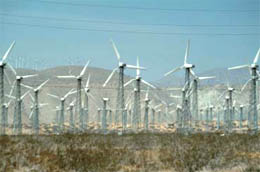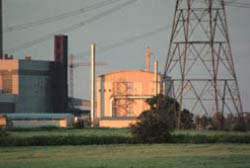U.S.-Japan Partnerships for the Environment
James T. Crow
Economic/Commercial Officer, U.S. Consulate Fukuoka
 |
James T. Crow |
Americans and Japanese share a keen interest in both energy security and the quality of the environment. People in both countries recognize that developing environmental technologies and making wider use of clean and alternative forms of energy, such as clean coal, nuclear power, biofuels, and renewable energy sources, are essential for ensuring energy security and addressing global climate change, as is engaging emerging economies. Both the United States and Japan have created policies that place a strong emphasis on developing and commercializing technology, and this is an area where bilateral cooperation can be particularly beneficial. Given the strong awareness in Japan of the importance of sustainable development and the advances that have been made in terms of environmentally friendly technologies, many U.S. businesses have been keen to engage in cooperative ventures with Japanese companies.
First, I would like to take a look at government-to-government cooperation, with links to more details about various initiatives. After that, I will introduce a variety of partnerships in the private sector in renewable energy, waste management, emissions reduction, and environmental monitoring. Finally, I would like to touch on public-private cooperation in the development of new technologies.
Government-to-Government Cooperation
U.S.-Japan cooperation on the environment dates back to 1975, when the U.S. and Japan signed an Agreement on Cooperation in Environmental Protection. In it, the two countries pledged to maintain and promote cooperation in the field of environmental protection through meetings of working-level experts; visits and exchanges of scientists, technicians, and other experts; implementation of agreed-upon cooperative projects; and exchange of information and data on research activities, policies, practices, legislation and regulations, and analysis of operating programs.
In June 2001, President Bush and then Prime Minister Junichiro Koizumi reinforced the importance of environmental protection when they agreed that the U.S. and Japan would cooperate on a broad range of joint climate change science and technology research activities and explore areas for common action. The two sides identified more than 30 joint research activities that will help us to understand, monitor, and predict climatic variations and their impact. In addition, the research will contribute to the development of advanced low-carbon technologies to limit net emissions of greenhouse gases.
More importantly, they recognized the significance of enhanced economic and other incentives to encourage private-sector research and development on climate change science and technology. Current and prospective cooperative activities include diversifying energy through nuclear power, clean coal, methane hydrates, and renewable energy, as well as improving energy efficiency.
As a result of the over 30 years of regular dialogue on the environment between Japan and the U.S., a number of partnerships have been initiated. A common thread among these is the necessity to reduce emissions and address climate change without hindering economic progress. This is particularly important when dealing with developing economies. The bilateral and multilateral partnerships in which the U.S. and Japan cooperate in confronting environmental challenges include:
- The Major Economies Process
- The Asia-Pacific Partnership on Clean Development and Climate (APP)
- The Global Earth Observation System of Systems (GEOSS)
- The Global Nuclear Energy Partnership (GNEP)
- The U.S.-Japan Workshop on Climate Issues and Co-benefits
- The International Pacific Research Center
- The Asia-Pacific Climate Change Research Network (APN)
Private-Sector Partnerships
In addition to the almost $37 billion the U.S. government has spent since 2001 on climate science, technology development, and incentives and international assistance, the U.S. has provided tax credits to private industry that will potentially leverage billions of dollars worth of private investment in the development and implementation of environmental technologies. Meanwhile, private-sector firms are working on their own to address serious environmental issues, and U.S. and Japanese companies are finding that there exist business opportunities they can better exploit when they work together in partnership.
 |
It is important to use renewable forms of energy in order to reduce emissions of greenhouse gases. (Photo: FreeFoto.com) |
Renewable Energy
There is a growing market for producing energy through the use of renewable resources, and progress in this area is being driven by both environmental and economic considerations. The widespread use of solar energy has long been a dream of environmentalists, but the relatively high cost of producing the necessary photovoltaic (PV) cells proved to be a bottleneck. In recent years, however, technological breakthroughs and rising energy costs have made solar energy more cost-effective, and U.S. and Japanese firms have been at the forefront, working together to develop this growing sector.
With a deep understanding of American companies' strong position in solar panel development, Sumitomo Corp. of America; Sumitomo Corp., Japan; Sanyo Electric Co.; and Sanyo Energy (USA) Corp. established a new company in the U.S. through the acquisition of Solec International Inc., the third-largest solar cell manufacturer in the U.S. and one of the oldest companies in the solar power industry. Solec was a key player in developing major improvements in crystalline silicon PV energy that are used in nearly all high-power PV applications. In 1997, Sanyo incorporated the crystalline cell technology resulting in a cell with the capacity of achieving a 20% efficiency rating. The company manufactures and markets crystal silicon solar cells and operates under the previous Solec International name.
 |
A wind farm in California (Photo: FreeFoto.com) |
Also in this area, in 2004 Sharp Corp. and its U.S. sales and marketing subsidiary Sharp Electronics Corp. signed a memorandum of understanding with the state of New Mexico for joint development in the field of new energy, including solar power generation systems and fuel cells. Under this agreement, Sharp is working with technology centers in New Mexico, including Sandia National Laboratories, Los Alamos National Laboratory, and New Mexico State University, to develop advanced calibration and testing for solar power generation systems and new solar technology applications designed to provide rural, off-grid, remote power generation for use in agriculture.
Biomass is another promising source of renewable energy, and two GE Energy Jenbacher gas engines are being used to generate 2 megawatts of electricity in Yamagata Prefecture using wood biomass from nearby forests, including trimmed tree branches.
Waste Management
While producing energy is one part of the equation, nations also have to find ways to deal with waste, and with its dense population and limited available land, this has always been an acute challenge for Japan. Japan's ever-present need for new and innovative ways to address this problem has provided numerous opportunities for collaboration between U.S. and Japanese companies, and the use of biomass to produce energy is a means of "killing two birds with one stone." Ebara Corp., a Tokyo-based Fortune Global 500 company specializing in engineering and manufacturing advanced industrial systems, and Exergy Inc., a San Francisco Bay Area energy technology firm, constructed a waste-incineration power plant in Fukuoka, Japan. The 4-megawatt plant can burn 200 tons of municipal waste a day and operates 20% more efficiently than other similar power plants. In another example, Fuji Electric Co. chose Foster Wheeler Corp. Japanese subsidiary Foster Wheeler K.K. in 2000 to supply boilers for Japan's first power plant utilizing fuel derived from waste products.
Not all waste can be burned to produce energy, though, and the disposal of some forms can be a difficult issue. In 2002, the American company Stericycle Inc. and Medical Safety Systems of Hokkaido, Japan, installed a new medical-waste treatment facility in Hokkaido. Stericycle's patented medical-waste treatment technology has great potential in Japan, where stringent environmental standards make it much more difficult and expensive to continue incineration of medical waste. Stericycle's Electro-Thermal Deactivation (ETD) process utilizes a dielectric oven in which low frequency radio waves are used to generate a high strength electrical field that heats the medical waste very rapidly, rendering it non-infectious. Moreover, shredding the waste reduces its volume by up to 89%.
And in an effort to address waste management even before the items are thrown away, NEC Solutions (America) Inc. in 2002 introduced the first ecological PC. This marked the first time a major computer manufacturer created a PC specifically to address growing environmental problems associated with the disposal of traditional desktop PCs, which include lead and non-recyclable materials. NEC Solutions' PC addressed these and other environmental issues by eliminating the boron that is commonly found in computer monitors, using lead-free solder and recyclable plastics, and reducing power requirements.
 |
An arable biomass renewable energy power station (Photo: FreeFoto.com) |
Emissions Reduction
Keeping the air clean has also been an area of interest in both countries, and Japan has been successful in overcoming industrial pollution through the utilization of technology to control emissions. Hitachi Power Systems America, for example, was awarded a contract in 2006 to install scrubbers (used to remove pollutants from industrial exhaust) in five of Ameren Corp.'s power plants in Missouri and Illinois. The technology alliance provides Ameren with access to Hitachi's current and future environmental technologies for controlling emissions.
Following a 2006 agreement with Kawasaki Heavy Industries to build power plants for FuelCell Energy, a manufacturer of "ultra-clean" and efficient electric power plants, its power plant operating at Seibu Wastewater Treatment Plant was certified by the Japan Institute of Wastewater Engineering Technology (JIWET) as meeting or exceeding standards for electrical efficiency, heat recovery efficiency, and air emissions. The certification was done in conjunction with the city of Fukuoka, the operator of the Seibu plant; Marubeni Corp., FuelCell Energy's Asian distributor; and Kyushu Electric, one of Japan's largest utility companies. Soon after the certification, one of the company's power plants was used to provide power to a university, a welfare institution, a high school, and a water purification plant in Sendai City.
Environmental Monitoring
A precise grasp of specific conditions, of course, makes it easier for companies and governments to protect the environment. An example of this can be seen in the subsidiary established in Japan in 2005 by Crossbow Technology Inc. in a joint partnership with Sumitomo Precision Products Co. Crossbow's networking products are designed to collect practical environmental data, including air temperature, relative humidity, ambient light, GPS location, solar radiation, barometric pressure, precipitation, and soil moisture and temperature. This data can be used to help industry improve agricultural efficiency, monitor and secure industrial plants and buildings, save environmentally sensitive lands, preserve national landmarks, mitigate earthquake and fire damage, and secure and protect the nation's natural resources.
Public-Private Cooperation in New Technologies
The Japan External Trade Organization (JETRO) in 2007 formed an independent advisory panel to preview and recognize influential technologies, services, and products to debut at CEATEC Japan 2007, Japan's leading electronics and IT trade show. Led by U.S. technology experts, the panel members were able to bring diverse viewpoints to new technologies and their impact on U.S. technology trends.
This year the U.S. Department of Energy's Argonne National Laboratory and Toda Kogyo Corp. of Japan reached a worldwide licensing agreement for the commercial production and sales of Argonne's patented materials, which have led to longer-lasting, safer batteries for hybrid-electric vehicles, cell phones, laptop computers, and other applications.
Conclusion
These are just a few of the examples of U.S. and Japanese companies working together on energy and the environment. With their high levels of technology, firms in the two countries are finding that cooperation enables them to make a profit while at the same time making a difference. The importance of such partnerships, along with government-to-government cooperation, will only continue to grow in the future.
